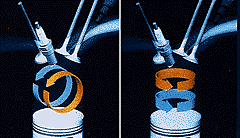
 MVV Engine
MVV EngineLean combustion engines were designed to enhance fuel efficiency without sacrificing power or drive-ability. All engines burn a mixture of air and fuel, but a lean-burn engine has a higher air-to-fuel ratio than conventional engines. This can mean significant savings in petrol, and thus in emissions like CO2.Mitsubishi is currently producing both 3-valve and 4-valve versions of our lean combustion engine, the Mitsubishi Vertical Vortex (MVV). They are in use in subcompact and compact cars in Japan. While most conventional petrol engines require an air-fuel ratio of 14.7:1, the MVV can achieve complete combustion with an air-fuel ratio as high as 25:1. More air in the mix means the MVV burns significantly less fuel.
The MVV engine works by inducing vertical vortices inside the cylinder, using a twin intake port design. The resultant barrel pattern of stratification uses the vertical vortices to maximum effect, ensuring that the influxes from the two intake valves do not mix with each other until the end of the compression stroke. This new concept differs considerably from conventional axially stratified lean-burn engines. The design of the combustion chamber ensures the total collapse and transformation into small-scale turbulence of the vertical vortices at the end of each compression stroke. This turbulence and mixture stratification provides accelerated, stable combustion.
At 40 km/h, the MVV engine provides 13 % better fuel economy than conventional engines.

At left, a conventional lean-burn petrol engine: axial stratification (top); flame propagation (bottom).
At right, Mitsubishi's lean-burn MVV engine: barrel strafitication (top); flame propagation (bottom).


NEXT TOPIC: "Ceramic Gas Turbine"

![]() Copyright 1995 by Mitsubishi Motors Corporation.
Copyright 1995 by Mitsubishi Motors Corporation.